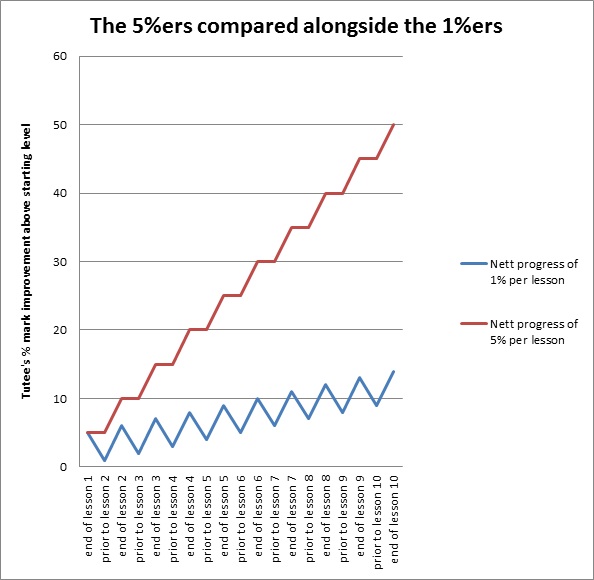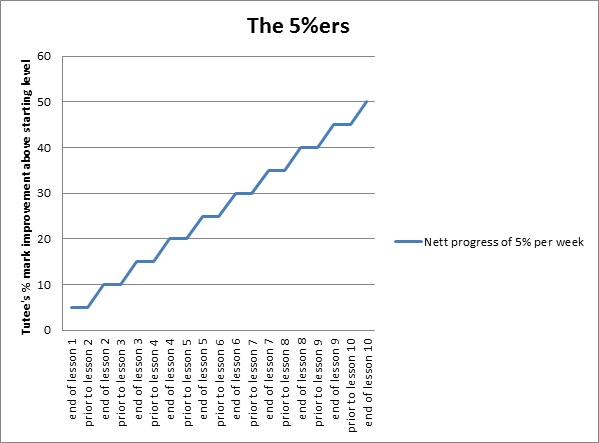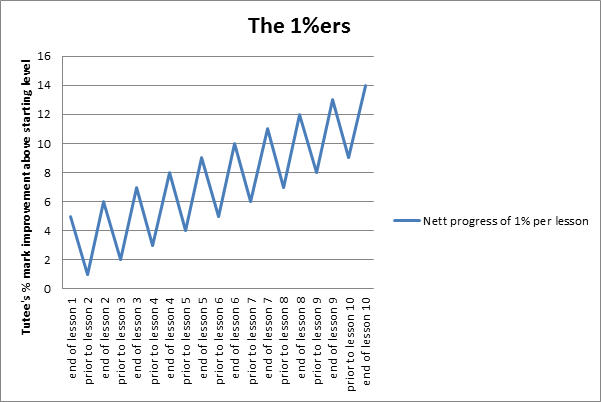Debunking a dangerous myth:
A misconception I sometimes encounter amongst students is that the simple act of hiring a maths tutor is enough in itself to guarantee success. Although not usually voiced aloud, this particular attitude towards tuition sometimes appears evident by the lack of study time some students commit to between lessons.
The belief that hiring a tutor will guarantee you more success for less effort is a false and potentially dangerous one which can invite complacency if not addressed early on. Paradoxically, if a tendency towards complacency sets in, with students expecting their tutors to carry them over the finish line, then these students can actually end up less well off for having the additional support than if they had decided to go it alone with hard work instead.
Hiring a private tutor can never replace hard work. In reality, the only remedy for poor grades is hard work and dedication. A student will gain as much improvement from work undertaken alone and between lessons as they will during their time with a tutor. This is because working in isolation in addition to working under the guidance of a tutor serves to reinforce and maintain the new concepts introduced from one lesson to the next.
There is no magic wand for transforming poor grades into good ones. Experienced teachers know this. In most cases, a teacher’s own effectiveness in communicating their subject and making it more comprehensible is largely the result of the trials and tribulations teachers themselves underwent in order to better understand their subject matter. It’s in the struggle to learn a subject thoroughly that an in-depth understanding is built up. The student’s efforts should likewise be directed towards the pursuit of a deeper understanding.
It may help to imagine your academic challenges as your own personal mountain to climb. In physics, some of you will have come across an equation for gravitational potential energy (G.P.E.) given by:
G.P.E = mass x acceleration due to gravity x height
or, when abbreviated:
G.P.E. = mgh (g ~ 10ms-2 or 10N/kg)
I believe this equation combined with the ‘mountain-climbing’ metaphor above provides a useful insight. It may be worthwhile dwelling on the above formula a little longer. What this formula tells us in real terms is that for an object to be displaced vertically in a gravitational field, work must be done against the force of gravity. As the object’s vertical position is raised through a given height, it acquires gravitational potential energy in direct proportion to its weight. For example, if we apply the formula above to calculate the energy needed (or work which needs to be done) to raise a 1kg object through a height of 10 metres, then we find that the work done is just the same as the amount of gravitational potential energy our object acquires after it reaches this height. This is given by
G.P.E. = 1kg x 10ms-2 x 10m = 100kgm2s-2, or in the conventional units for energy, just 100 joules.
I would suggest then that you try to imagine your own effort requirements as representing the amount of work you need to put in so as to displace yourself vertically to the top of your own personal Everest. If the G.P.E. required is ‘x’, then you should not kid yourself into thinking you can reach the top of your climb having invested anything less than ‘x’! It’s simply a matter of physics. What’s more, there are no cable cars on standby to make your journey less arduous either. At best, a tutor can show you the less arduous routes so that your ascent seems less like an impossible struggle; they can show you those paths of least resistance and gentler gradients. The ascent to the top then becomes less of an ordeal. As for carrying you up there, however, I’m afraid not.
Effective teaching ‘reminds’ more than it ‘instructs’. Greatness is to be uncovered in the student, not added. In this sense, teaching amounts to no more than facilitating that journey. Ultimately, the student needs to engineer their own success since it’s the student alone who will have to sit the exams at the end of their preparation.
I have listed below five of the most important strategies that tutees should seek to adopt in order to maximise their benefits from one-to-one tuition. Failure to adhere to any one from five is liable to seriously jeopardise the tutee’s chances of success.
Five important tips for tutees:
1) Strive to understand fully all the concepts covered during the lesson. Interrupt with questions as often as you need to and remember: there’s no such thing as a stupid question when the answer coming back at you imparts greater understanding.
2) Between lessons, make the time to go over lesson notes and to redo every single problem tackled during lessons in order to ensure you can arrive at the solutions accurately, quickly and independent of your tutor. It’s all very well being able to answer these problems under guidance, but can you do so completely under your own initiative? The tutor’s job is to help you make yourself completely self-dependent and not tutor-dependent; to serve the best interests of the student ahead of expediency. Effective tuition, then, should render the student self-sufficient and the tutor redundant, and it should seek to do this as quickly as possible. You can speed up this process by working effectively between lessons (actually, it would seem tip 2 has turned out to be advice for tutors as much as advice for tutees!)
3) Be both self-critical and your own best judge when it comes to your progress. If there are topics within the syllabus or specific problems still troubling you, then you will undoubtedly be the best judge of which ones they are. Target these questions and practice them as often as you can until you’ve mastered them. Settle for nothing less than complete mastery of these problems and keep good open lines of communication with your tutor to facilitate this pursuit of excellence.
4) Organise your paperwork effectively. Make sure you have your syllabus and ‘past paper’ checklists readily available to review your progress on a regular basis. These checklists will provide you with instant feedback as to how far you have come and how far you still have to go. These checklists will also help you visualise your path to the mountain top, so to speak. And they will help you chart the course which will get you there. After all, you can’t hit a target you can’t see. If you can visualise what needs to be done, it makes it that much easier to do and ensures you’re not wandering about aimlessly. At MME, I always look to furnish each new student with customised checklists to facilitate their studies. I also suggest that students use these checklists to highlight any of the practice questions they are finding troublesome so that any weaknesses can be effectively exposed and ironed out.
5) Finally, set yourself targets from week to week and be driven by them. Put the effort in and you will be rewarded. It’s not impossible to add an average of 5% per week to your final exam result, but this will depend largely on how closely you adhere to all of these guidelines. Set yourself mock tests and see for yourself how effectively you can adopt all of these strategies to improve your scores in extra quick time.
Are you a 1%er or a 5%er?
In terms of marks added to final exam results, I would estimate that the weekly rates of progress achievable will vary from 1% to 5% on average. Basically, those students who adopt the guidelines above, or similar methods of their own, will be closer to 5% per lesson, and those who don’t will probably end up being closer to 1%.
I’ve often finished a particularly intense and productive lesson convinced the student is 5% better off than before the lesson began. Sadly, this thought is then usually followed swiftly by one more pessimistic reminding me that as much as 4% of that gain might potentially be lost before the following week’s lesson simply due to the student neglecting to do the work needed between lessons to reinforce learning.
A large reason for such neglect on the part of the student probably comes back to the misconception I set out at the beginning of this article. So I will repeat the warning once again: it is complete fallacy to suggest that any student requiring one-to-one tuition can rest on their laurels and expect to gain enough from the work done in lessons alone without putting the extra work in between lessons.
Let’s compare two students, A and B, and see how their rates of progress compare with one another. Student A is a 5%er who follows all the guidelines outlined above, ensuring that everything gained in the lesson is practiced and maintained going into the next lesson. He effectively uses his past learning as stepping stones to help him advance progressively up to higher levels. Student B on the other hand, being neglectful of his studies between lessons, is very much a 1%er. Although he experiences a real boost in his abilities immediately following one-to-one tuition sessions, he fails to reinforce and maintain his advantage, so this new learning wears off as the week progresses. Through lack of practice and maintenance his lessons fail to ‘stay learnt’.
I will model both these hypothetical students’ rates of progress graphically to give you a dramatic depiction of the stark contrast in results which students can expect depending on which of the two extremes of approach they adopt.
The 5%er approach
The 1%er approach
The 5%ers compared alongside the 1%ers

You can see for yourself from the last graph above the vast contrast which exists between
the two extremes of approach by the time lesson number 10 is over. The 5%er can expect to add 50% to his or her exam mark over this period of time and the 1%er barely 15%. Although the above results are theoretical with 5% progress probably representing an upper-bound, students should nevertheless challenge themselves to get as close to this rate of progress as possible. At the very least, they should aim to be closer to the 5%er rate than the 1%er.
In conclusion, I hope those not already doing so will see from the graphs above the clear advantages which are to be had from adopting my 5%er approach. In many cases, the 1% approach is far from guaranteed to move you up to even a passing grade. So do not be lulled into the false sense of security that your tutor will somehow make things turn out fine in the end. If you develop this particular mind-set, you may well prove to be at more of a disadvantage than if you had simply adopted the tactic of hard work and struggle in place of one-to-one support.
To finish on a more upbeat note, we can also see from the graphs above that hard work in addition to effective tutoring methods can help a student climb to heights previously undreamt of. This combination of hard work on the part of the student, and effective teaching methods on the part of the tutor, can leave the student virtually at liberty to choose their final grade.
If you feel ready to take on the challenge of trying to raise your own final maths grade by 5% per week through assisted learning, then please feel free to visit my maths tutoring services page at http://www.mathsmadeelementary.co.uk/maths-tutoring-services.html where I aim to give all my students every possible opportunity of doing just that.


